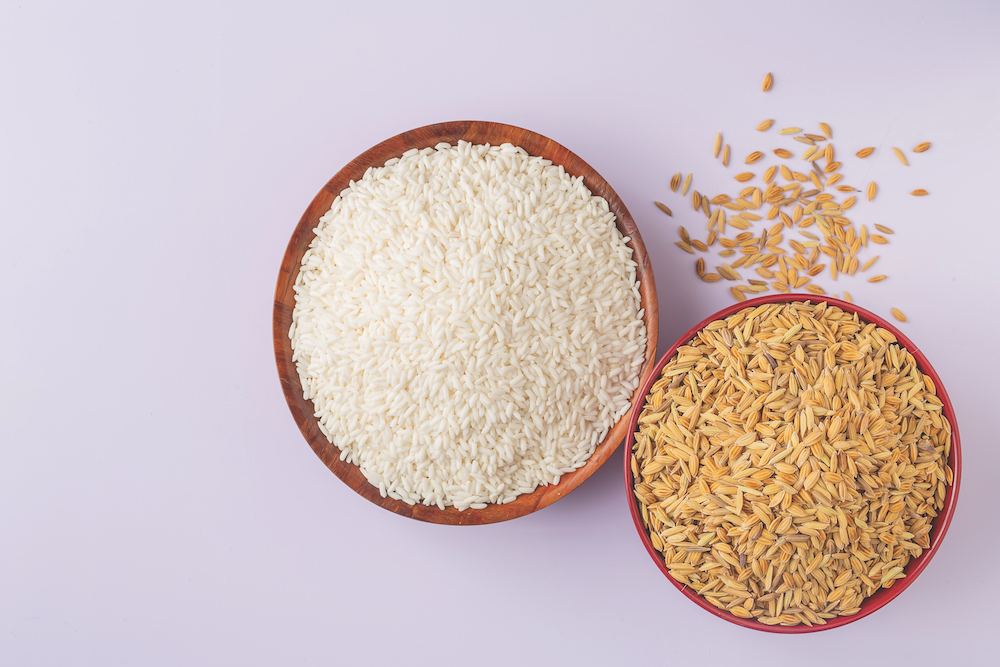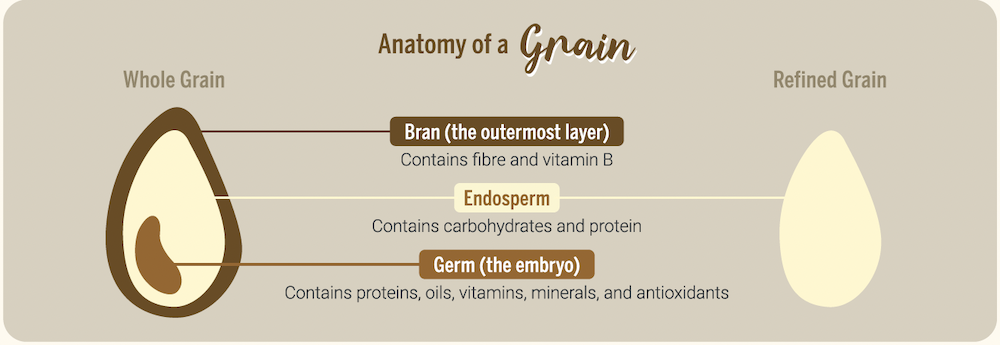News & Articles

7 Common Types of Grains to Eat and Their Benefits

There are many different types of grains, each with its own unique nutrient profile. As one of the largest sources of nutrition in the world, they form an essential part of a healthy diet. Senior Dietitian Chloe Ong shares more.
Grains are the edible seeds of plants in the cereal family.
There are many types of grains, the most common being rice, oats, wheat, barley, millet, buckwheat, couscous and quinoa.

Grain foods are typically categorised as either whole or refined.
Whole grains are grains that have been minimally processed, and contain the bran, germ and endosperm, whereas refined grains only contain the endosperm.
The endosperm is the largest component of a grain, making up about 85 percent of a whole grain kernel, yet it is 15 percent of the whole grain which contains valuable fibre and most of its nutrients and antioxidants.
However, compared to whole grains, refined grains usually have a longer shelf life. This is because the oily germ in whole grains tends to become rancid when exposed to light and heat.
7 Common Types of Grains to Eat
Grains are a good source of nutrients, each with their own unique nutrient profile and health benefits.
On top of nutrient profiles, you may also want to take note of the Glycemic Index (GI) of the types of grains that you choose, especially if you are concerned about your blood sugar levels. We usually aim to have a lower GI (<55) for better blood sugar control.
Here are some common types of grains you can incorporate into your everyday diet:
Rice
All white rice starts out as brown rice. White rice is refined grain rice that typically undergoes a milling process to remove its husk as well as its bran and germ, while brown rice is whole grain rice with the outer hull removed.
Although the milling process increases the shelf life of white rice, it removes much of its nutritional value, including fiber, vitamins and minerals. One cup of cooked white rice contains only less than 1 gram of fiber compared to one cup of cooked brown rice, which contains 3-5 grams of fiber and about 5 grams of protein.
In addition to higher fiber, brown rice has a lower GI of about 50, and is also more nutritious as it is rich in vitamins and minerals, such as Vitamin B, Potassium, Magnesium, Zinc, Iron, Selenium and Manganese.
Oats
Oats are whole grain foods with a well-balanced nutritional composition. It is a good source of carbohydrates, protein and fiber, including beta-glucan, a type of soluble fiber that is good for heart and gut health. One cup of cooked oatmeal contains about 6 grams of protein and 4 grams of fiber.
Depending on how the oats are processed, steel-cut oats or rolled oats have a lower GI of about 50, while instant oats have a higher GI of about 80.
Quinoa
Quinoa is technically a seed, but it is classified as a whole grain because of the way it is cooked and consumed, as well as its similar nutritional profile to grains.
Quinoa is a complete protein, which means that it contains all nine essential amino acids that our bodies cannot produce on their own. One cup of cooked quinoa contains 8 grams of protein and 5–6 grams of fiber. It also contains essential minerals like Iron and Magnesium.
Quinoa has a GI of 53, which is considered a low GI food.
Barley
Barley tastes slightly sweet and nutty, with a chewy texture. It is a type of grain that is high in fiber and antioxidants. One cup of cooked barley contains about 3 grams of protein and 6 grams of fiber. It is also a great source of Vitamin B-complex, Iron and Magnesium.
Barley has a low GI of about 26 when prepared without adding sugar.
Millets
Millets are small, round, whole grains which are starchy, protein-rich, and a good source of Phosphorus, Magnesium and Calcium. One cup of cooked millet contains about 6 grams of protein and 2 grams of fiber.
Depending on the shape of millets that you choose, the GI of millets are typically between 50–60.
Couscous
Like quinoa, couscous is technically not a grain nor a seed; it is a form of pasta made from a dry mixture of semolina and water that is rolled in very tiny, irregular pieces.
The health benefits associated with couscous are derived from its rich mineral and vitamin content, which include selenium thiamin, niacin, folic acid and manganese.
One cup of cooked couscous contains about 6 grams of protein and 2.5 grams of fiber. It has a medium GI of about 65.
Buckwheat
Buckwheat is part of a group of foods known as pseudocereals, which refer to seeds that are consumed as cereal grains, like quinoa.
The main component of buckwheat is carbohydrate, but it is also high in protein, fiber and many different types of minerals and antioxidants.
One cup of cooked buckwheat contains 6 grams of protein and 4.5 grams of fiber. Buckwheat may be a healthy choice of carbohydrate as it has a low GI of about 30–35.
Looking to add grains to your diet but not sure where to start? As a simple guideline, try to work grains into every meal. Choosing whole grains over refined grains will also ensure you enjoy more nutritional benefits. This can be as simple as switching from white rice to brown rice, or opting for whole grain bread for breakfast. By making a few simple ingredient swaps, you can add more nutritional value to your daily diet.
| POSTED IN | Nutrition |
| TAGS | cancer diet & nutrition, healthy food & cooking, healthy lifestyle |
| PUBLISHED | 01 January 2023 |
